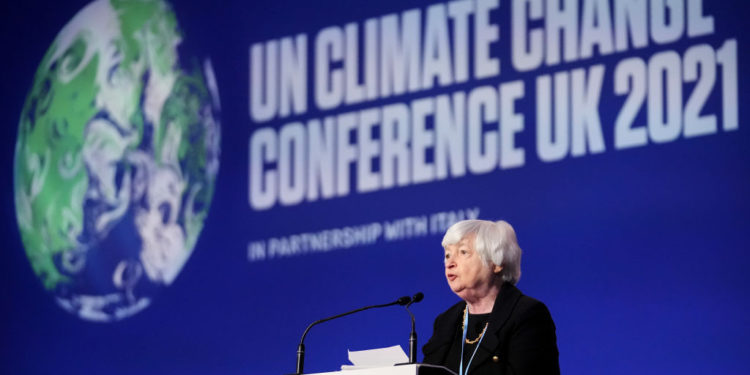Companies Need to Consider These Four Factors When Setting a Climate Target
Coming out of COP26, the role of investors and companies in addressing the climate crisis is clearer than ever. The UN’s two-week annual climate conference saw notable moves from the private sector to finance and standardize the transition toward a zero carbon economy.
The Glasgow Financial Alliance for Net Zero, a coalition of over 450 asset managers, banks, and insurers, announced that it now has $130 trillion of capital committed to helping economies reach net zero emissions by 2050. That marks an uptick from $5 trillion in committed capital when the Alliance launched in April. “We now have the essential plumbing in place to move climate change from the fringes to the forefront of finance so that every financial decision takes climate change into account,” said Mark Carney, chair of the Alliance and former head of the Bank of England.
As climate considerations further factor into financial decisions, COP26 also underscored the importance of standardization. The launch of both the Science Based Targets initiative’s (SBTi) Corporate Net Zero Standard and the International Sustainability Standards Board sent a signal to companies that transparency and clarity on climate action is a must-have. The infusion of interest and capital in fighting the climate crisis needs to be matched with clear action from companies on the development and execution of their own climate commitments.
Nearly three-quarters (74%) of Americans we surveyed with The Harris Poll said that they believe companies can have a high or moderate impact on addressing global climate change by committing to climate goals such as reducing greenhouse gas emissions. Our most recent analysis of the Russell 1000 found that 400 of these companies have an emissions reduction target. But, at present, there are no current standards for creating corporate climate commitments.
That’s why we reviewed the targets of these 400 companies and identified four factors companies should consider to set a credible climate commitment.
It’s understandable
Corporate climate commitments must disclose sufficient information and detail while avoiding confusing jargon, which can misrepresent ambitions and action to employees, customers, investors, policymakers, and other key stakeholders. By clearly explaining their goals and the terminology attached to them, companies ensure any audience can understand their baseline commitments and their performance against these targets. Intertwined in these efforts is the ability to compare year-over-year corporate emissions, which can ultimately show if a company is reducing emissions in line with their goals.
Mastercard’s sustainability disclosure is a great example of this. The company’s sustainability report clearly shows its emissions reductions from 2017 to 2020 and how these measure up to its targets.
Other experts in the sustainability field have also stressed the importance of clear disclosure language. “This is why I would love it if the greenhouse gas inventories became a common ledger that people understood like a profit and loss statement, because you can see very quickly what is a credible commitment if you understand what the actual emissions portfolio of a company is,” Verena Radulovic, Vice President of Business Engagement at Center for Climate and Energy Solutions said during our Climate Week session.
It’s comprehensive
Climate commitments must also be comprehensive. They need to cover the entire organization’s operational emissions – from direct sources like boilers and furnaces (Scope 1) and purchased electricity (Scope 2), but also from supplier or customer activities (Scope 3). These Scope 3 emissions are especially important to address because “they can influence all the value chain partners from the raw material extraction to the disposal of the products they sell in reducing emissions,” Cynthia Cummis, Director of Private Sector Climate Mitigation at the World Resources Institute and SBTi Technical Director and Co-Founder, said in our event.
The majority of a company’s emissions profile often rests in Scope 3 emissions, but they are largely unreported and, when they are, it is typically only across a few of the 15 categories of emissions activities. Our analysis of Russell 1000 companies found that while over 100 have committed to net zero emissions by 2050, only 44 have also disclosed emissions from the two Scope 3 categories we measure: emissions from business travel and emissions from the use of sold products.
It’s innovative
Climate commitments that address the specific needs of companies and account for industry-specific idiosyncrasies prove to be some of the strongest. Different sectors have different emission rates based on the product or service they provide, creating a more challenging pathway for certain businesses. A one-size-fits-all approach simply does not address the realities of many companies. Regardless of a company’s sector, setting and meeting a net-zero target is achievable if companies are willing to invest the resources into creating a plan that works for them. This can be achieved through partnerships with organizations like the SBTi, which works alongside companies to provide an individualized assessment to determine a net-zero plan that works best for them.
Etsy is an example of a company that has established a science-based net zero commitment that aligns with its business practices while providing consumers with transparency. As an online retailer with independent sellers, Etsy required an innovative solution to minimize its Scope 3 emissions. The company chose to offset all carbon emissions from shipping through the purchase of verified Renewable Energy Credits (RECs) in 2019. Etsy has since committed to meeting a net-zero target by 2030, as verified by SBTi, and aims to focus on integrating more sustainable suppliers into its supply chain, helping to decarbonize the transportation sector.
Procter & Gamble is also investing in an innovative approach to achieving net zero emissions. The company pledged to reach net zero emissions across its operations and value chain by 2040 through implementing multiple science-based approaches. P&G has committed to eliminating deforestation in its supply chain, and set a target to ensure its paper and hygiene products are verified by forestry management standards. The company is also transparent about how some of the necessary technology needed to reach net-zero, specifically within Scope 3 emissions, is not yet available. However, P&G is being proactive and investing in start-ups that focus on developing carbon-capturing technology with the hopes of integrating it within its own manufacturing processes.
It’s achievable
The best quality commitments have interim targets, which signal the company has a plan for implementation and will not wait until 2049 to turn to its 2050 goal. This incremental framing provides a monitoring mechanism to understand if a company is on track to meet its goal. Recent research found that only 8% of companies with a net zero plan have set interim targets, a statistic that Claire Kells, Senior Manager, Corporate Engagement at the UN Global Compact noted in our Climate Week session.
Microsoft’s one year update of its path to achieving its carbon negative goal is a great example of how to communicate, and is a sign that the company is constantly assessing its progress and is not afraid to share its peaks and pitfalls on the journey toward carbon negativity. Sharing the latter is especially important because although competition is inherent in business, there needs to be a level of private sector cooperation to limit warming below 1.5°C. Other companies at earlier stages of emissions reduction can learn from Microsoft’s actions and accelerate action across the board.
While it is important to prioritize these criteria in climate commitments, it is also important to acknowledge that every company and every industry is on a unique journey to reducing emissions and limiting warming. There is no singular strategy to reach these targets. How each company incorporates these elements will, and must, look different.
Instead, we are looking for companies to hold themselves accountable for their emissions and commit to the process of eliminating them. Companies have the power to lead on this issue and create influential change by establishing more sustainable business practices that will shift how we consume energy overall. By setting climate commitments that are understandable, comprehensive, innovative, and achievable, companies can prioritize the needs of our planet and help fight the climate crisis.






